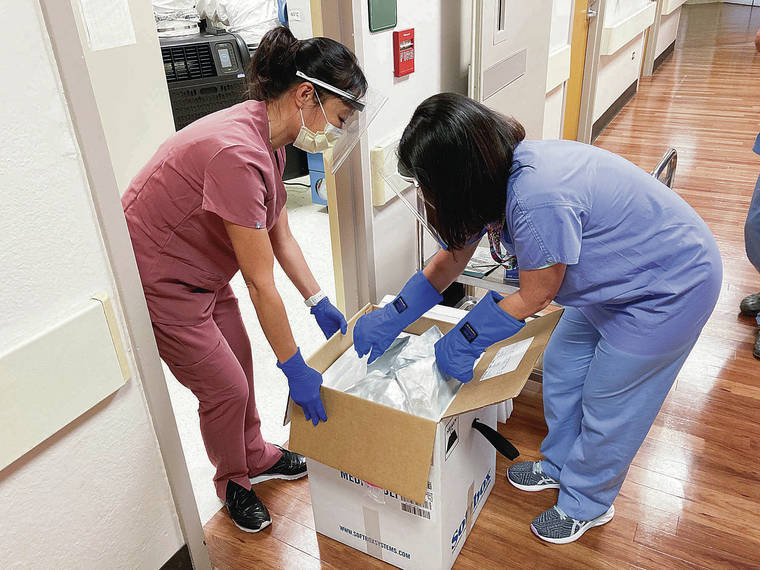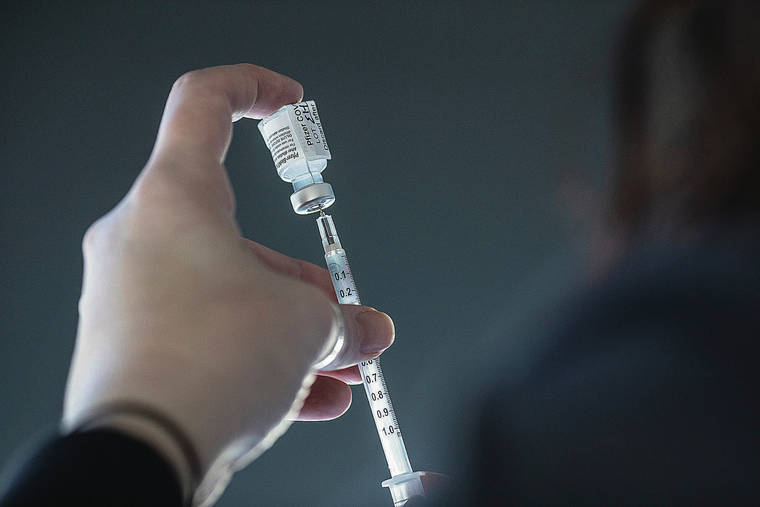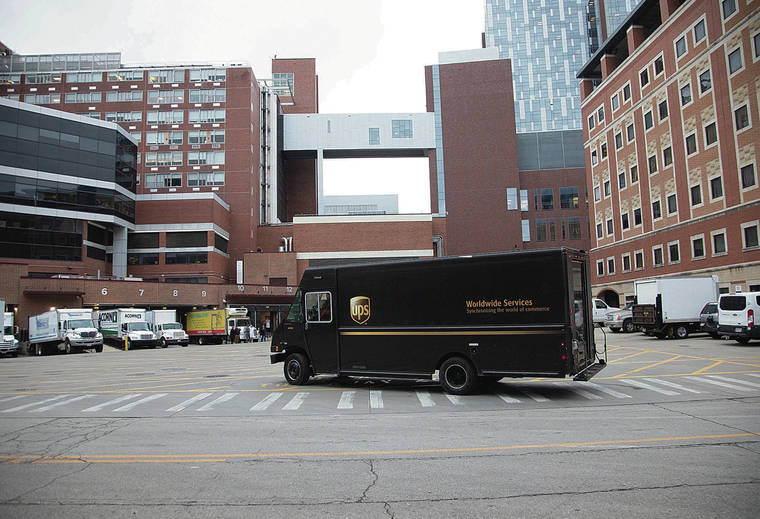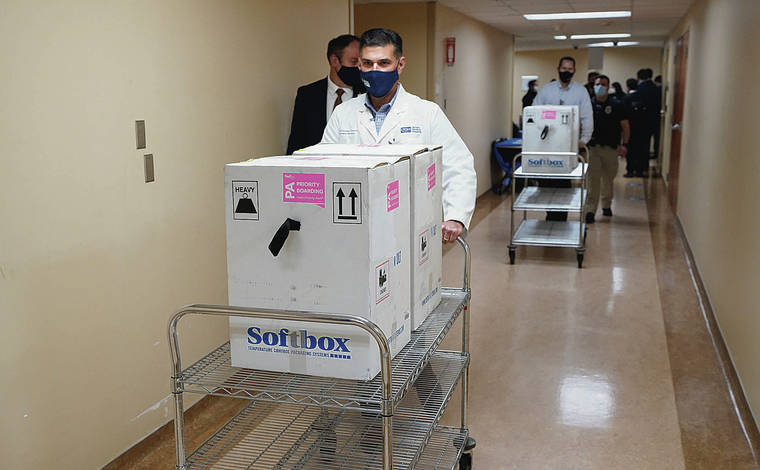Vaccines arrive in Hawaii, thousands more on the way

QUEEN’S MEDICAL CENTER
The Queen’s Medical Center staff members unload its first batch of the Pfizer coronavirus vaccine on Monday.

NEW YORK TIMES
The first shots were given to Americans in a mass vaccination campaign Monday, opening a new chapter in the battle against the coronavirus pandemic. Above, the Pfizer COVID-19 vaccine was readied for the staff at the University of Iowa Hospital in Iowa City, Iowa.

ASSOCIATED PRESS
A UPS truck delivered the first vaccines to the Ohio State University Wexner Medical Center.

ASSOCIATED
At the Tampa General Hospital in Tampa, Fla., staff members carted the vaccines.




Hawaii received its first delivery of COVID-19 vaccines Monday, in what hopefully will mark a turning point in the state’s battle against the COVID-19 pandemic, which has sickened nearly 20,000 people and left 274 dead.
The Queen’s Medical Center received a shipment of 975 doses of Pfizer’s COVID-19 Opens in a new tab vaccine and will begin immunizing front-line workers today.
Another 3,900 doses are expected to arrive Wednesday, with nearly 45,000 more Pfizer vaccines coming this month. In addition, 36,000 doses of the Moderna vaccine are expected by year’s end, pending approval from the U.S. Food and Drug Administration.
Gov. David Ige hailed the step as “an important milestone in the ongoing effort to combat COVID-19 and return life to normal.”
“It is gratifying to be able to offer the vaccine to health care workers who have sacrificed so much to protect all of us,” Ige said in a news release. “The vaccine provides another important layer of protection to safeguard our kupuna and others in long-term care facilities.”
The City and County of Honolulu and state Department of Health conducted practice drills Monday as officials prepare to establish vaccine clinics for first responders, essential health care workers and long-term care residents and staff statewide.
Don't miss out on what's happening!
Stay in touch with breaking news, as it happens, conveniently in your email inbox. It's FREE!
Health care workers with direct exposure to coronavirus patients — including those in emergency departments and intensive care units — will be first to be immunized along with residents of long-term care facilities.
Queen’s, which has 5,400 employees at Punchbowl, 1,000 at the West Oahu campus as well as 350 at North Hawaii Community Hospital on Hawaii island and 200 at Molokai General Hospital, will also immunize employees treating at-risk populations, those with chronic conditions, seniors and eventually “everyone in the organization” over the next few months.
Hospital executives said the vaccine is not mandatory for employees, but highly encouraged. The vaccine, which must be stored at minus-60 degrees, was shipped in containers containing dry ice and transferred to the hospital’s ultracold freezers.
“This is indeed a momentous day. We have been looking forward to this day for a long time,” Jill Hoggard Green, president and CEO of The Queen’s Health Systems, said in a news release. “This vaccine will give us another layer of protection against this devastating disease.”
Headaches, sore muscles and fatigue are a few of the side effects described by Hawaii physicians who were part of a national COVID-19 vaccine trial.
Dr. Kelley Withy, an Oahu doctor who participated in the Pfizer vaccine trial, dealt with soreness in the shot area for roughly three to four days, along with mild headaches for about the same time period.
“Now I feel just a little invincible, and I’m really glad I did it. I absolutely believe in the science behind the vaccine,” said Withy, describing herself as a “cautious” family physician. “I’m hoping that when 70% or so get immunized, we’ll be able to go back to normal.”
Dr. Eric Lau, a Honolulu radiologist, enrolled in the same trial in September with about 40,000 others worldwide, half of whom received a placebo. He and Withy said they both experienced side effects, which is why they believe they got the real vaccine.
Lau said the first sign of side effects happened about six to eight hours after the injection when his left arm where the shot was administered started to throb.
“The arm pain felt sort of like a flu vaccine but worse, like a really bad muscle bruise,” he said in an email.
On the second day he felt “extremely fatigued” with “associated generalized muscle aches.”
“I felt really lethargic and was pretty wiped out,” he added. “I was pretty much nonproductive and just wanted to take a nap for the entire day.”
He said he felt better the next day and that by Day Four his energy level was “pretty much back to normal,” though the arm pain persisted for six days. By the seventh day the symptoms were gone.
However, he went through the same symptoms after getting a second shot three weeks later, plus a new side effect: swollen and tender lymph nodes in his left armpit, the same side as the shot.
Five weeks after the initial injection, Lau tested positive for COVID-19 antibodies, which indicates he will not be susceptible to the virus. Scientists still don’t know whether people who get vaccinated can still carry the virus and infect others. They also don’t know how long immunity lasts.
“Until these questions are answered, we must continue to protect ourselves and the people we love by wearing face masks and physical distancing,” said state Health Director Libby Char.
Health officials reported 190 new coronavirus Opens in a new tab infections statewide Monday, bringing the total since the start of the pandemic to 19,424 cases. An outbreak at the Halawa Correctional Facility accounted for 85 of the 158 new infections reported for Oahu.
The state’s official COVID-19 death toll remains at 274, with no new deaths reported.
Nationally, coronavirus deaths have surpassed 300,000 with infections topping 16 million since the start of the pandemic; the worldwide death toll is more than 1.6 million with over 72 million confirmed infections.
“I weighed the risks versus benefits, and for me it was a no-brainer to enroll in the trial,” Lau said. “At the time I enrolled, there was no efficacy data out, but I figured that if the vaccine offered some protection against COVID-19, some protection would be better than none. To me it was definitely worth it to enter the trial, especially if there was some chance to protect elderly family members/grandparents.”




